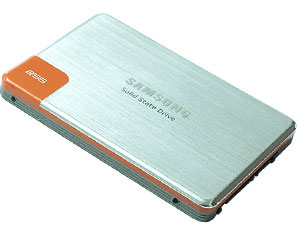Samsung 470 Series 256GB SSD Review
Samsung 470 Series 256GB SSD

No funny business here -- Samsung's drive adheres to the 2.5-inch form factor like most other SSDs, which means you can slide it into just about any modern notebook, though you'll need a 3.5-inch drive adapter for use with most desktop cases.




This is easily one of the more attractive SSDs we've seen to date and it's almost a shame to hide it inside your desktop or notebook chassis. Constructed of brushed metal with an orange border reminiscent of Samsung's 'Touch of Color' found on HDTVs and LCD panels, the aesthetics match the price tag.
We don't recommend popping the case open, as it's both risky and would undoubtedly invalidate the warranty if Samsung found out about it, but should you need to take a peek inside, the top shell pries right off with a little finesse. There aren't any screws holding it in place, it's just clipped on. It's best to use a plastic spunger for something like this, a handy tool for prying open all sorts of components without worry about scratching the surface should you slip. Note that if you're going to attempt this, lift the casing from beneath the orange border, not on top of it, otherwise you'll end up removing just the thin metal sheet on top and need to glue it back on.


We don't recommend popping the case open, as it's both risky and would undoubtedly invalidate the warranty if Samsung found out about it, but should you need to take a peek inside, the top shell pries right off with a little finesse. There aren't any screws holding it in place, it's just clipped on. It's best to use a plastic spunger for something like this, a handy tool for prying open all sorts of components without worry about scratching the surface should you slip. Note that if you're going to attempt this, lift the casing from beneath the orange border, not on top of it, otherwise you'll end up removing just the thin metal sheet on top and need to glue it back on.


Inside our 470 drive we see Samsung's branding all over the place. That's because Samsung's using its own controller instead of a JMicron, Indilinx Barefoot, or SandForce chipset that's so prominent on most other SSDs. Samsung's also using its own MLC NAND flash memory as well as a pair of 128MB DDR2 modules (256MB total) acting as a cache buffer to prevent any stuttering or lag.




Combined with the SATA II interface, Samsung's controller helps push read speeds up to 250MB/s and write speeds up to 220MB/s, which is really an evolutionary step above early generation SSDs, though not quite on par with drives inching close to 300MB/s. Tree huggers will be happy to know the 470 series comes rated at just 0.14 watts when idle and a scant 0.24 watts when crunching data.






